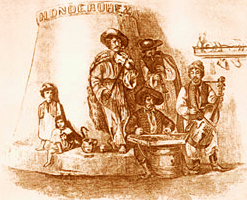

The Basso is a traditional piece of Gypsy music. The term Gypsy music is often used to refer to the music of the Roma. The Roma or Gypsies are thought to have migrated from northern India to Europe over 1,000 years ago, and their presence as entertainers and musicians in European royal musical courts beginning in the 1400s is well documented (the term Gypsy also refers to "Traveller" groups from other countries, but this brief description will focus on the Roma Gypsies). It should be noted that there is some controversy over using the term Gypsy. Some Roma regard Gypsy as a derogatory term, and prefer to be called by their tribal name or by the name Roma. Rom means man or person in the Gypsy language, Roma is plural, and Romani and Romanes are names for the Gypsy language. [1] [2] [3]
One of the reasons why it is difficult to characterize Gypsy music, is because the Roma musicians were both influenced by and exerted an influence upon the music of the countries they were living in. The following author described how this took place:
Roma musicians absorbed music from the new territories, and in turn influenced the locals—you can hear it in everything from the modes and percussion of Turkey to the raw duende of Spanish flamenco. But their influence was greatest across the Balkans and Central Europe, where it was often the Romany musicians who earned their living by playing for village weddings, feasts and celebrations of all kinds. They became familiar with the music of different parts of the Balkans where they settled, adding their own flourishes, which in turn became standard fare for local musicians. The Roma would travel throughout the region, playing, taking in sounds and ideas and adding them to their own. It became commonplace to see Gypsy and Jewish klezmer musicians playing together, and klezmer took on some of the characteristics of Gypsy music and vice versa. [4]
Music scholar David Malvini attempted to define Gypsy music as being an emotive performance style containing the values of emotion, virtuosity and improvisation: "Roma musicians offered a different, 'Easternized' alternative to European performance practice. The positive trope of the exoticism became what I theorize as Gypsiness: the idea that improvisation combined with stunning virtuosity creates an emotionally charged atmosphere." [5]
TECHNIQUE TIPS: The Basso is a traditional Gypsy piece, and stringed instruments such as the violin are often used to play the melody. This arrangement is in a minor key, and should be played with virtuosity, expressiveness and passion. If you find it too difficult to use separate, short bows when you play the rapid notes in measures 34-37 and 42-45, you could try using slurs for these sections. You may want to listen to different regional versions of The Basso, e.g. the Russian version sounds slightly different from Hungarian version, and each performance varies as musicians use improvisation and ornamentation to add their own unique style to the piece. To find different interpretations of The Basso, you could conduct an Internet search for different audio and video versions of The Basso, and pattern your playing after the style you like best. [6] [7] [8]
© Copyright 2025 RK Deverich. All rights reserved.
Although this online cello class is provided free of charge, all rights are reserved and this content is protected by international copyright law. It is illegal to copy, post or publish this content in any form, and displaying any of this material on other websites, blogs or feeds is prohibited. Permission is given for individual users to print pages and perform music from this website for their personal, noncommercial use.